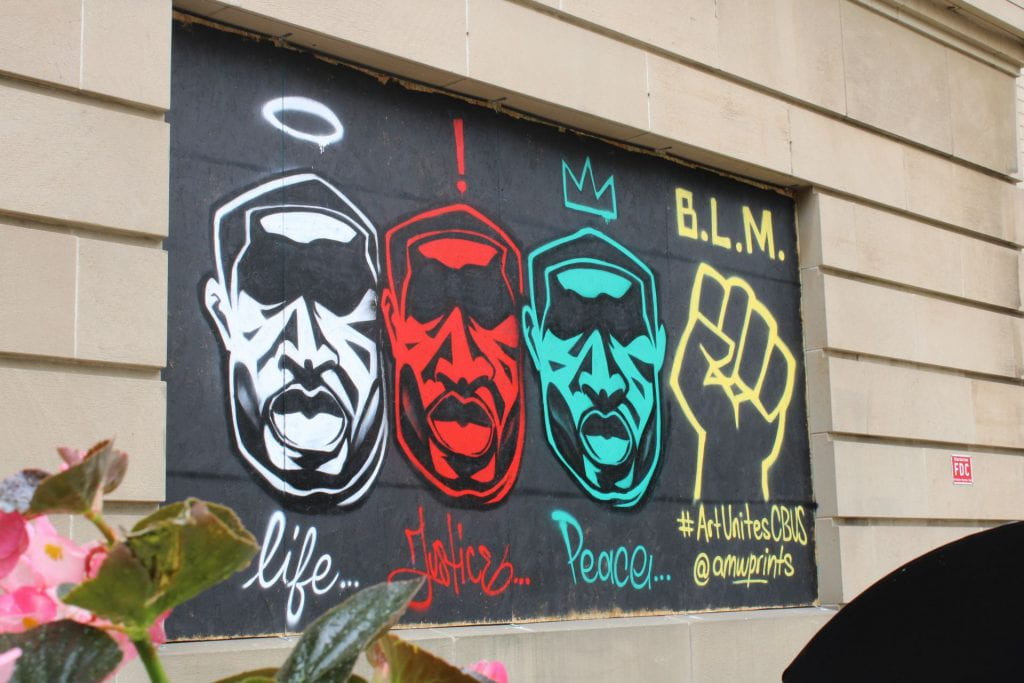
Murals have been painted on the plywood covering windows and doors of businesses in Columbus, Ohio. Credit: André White | Arts & Life Producer
Quiet but echoing symbols of protest hang on business fronts along the streets of Columbus, Ohio, demanding their passersby’ attention.
For nine days now, more than a thousand people have taken part in protests in downtown Columbus following the death of George Floyd, a black man who was killed May 25 while in the custody of Minneapolis police.
Following the main demonstration Sunday, some people damaged storefronts and looted businesses during a citywide curfew. Many businesses started to board up their windows and doors to prevent further damage. In response, the Columbus Association for the Performing Arts partnered with the Greater Columbus Arts Council for a creative solution to decorate the plywood coverings. Their initiative, #ArtUnitesCbus, employs local Columbus artists to paint murals on the plywood of boarded-up business fronts.
“We can use art to make a statement of unity and healing and love,” Jaimi Goldstein, Greater Columbus Arts Council spokesperson, said.
Bryan Moss, a local Columbus artist, said the initiative would not only make a statement but help give a voice to those who needed to be heard most.
“I don’t protest,” Moss said. “Not necessarily because I don’t support it, but because I’m a black male and if I’m in jail I get a criminal record. Then I can’t teach in schools.”
Moss is one of the artists designing the murals. He currently has designed and collaborated with artists on the #ArtUnitesCbus murals that cover the entrance to the Pizzuti Collection of the Columbus Museum of Art and the business front of Smart Columbus, located on Civic Center Drive.
The initiative has given him a peaceful outlet to voice his support for the Black Lives Matter movement, he said.
“The appreciation, along with everyone who was shocked or saw the impact the art could actually do for the city, was kinda overwhelming honestly,” Moss said. “It was like a second wave of understanding, love and compassion. It was flabbergasting really; I’m still wrapping my head around it.”
In order to connect artists with businesses, the Greater Columbus Arts Council created a toolkit that can be found on their website which consists of a database for artists to showcase their work and an email template for businesses to reach out to them.
“The organic interest in it has been amazing, and I’m really grateful for it,” Goldstein said.
The work created by the artists is left entirely up to their discretion. Murals have varied in their imagery, from showing support for the Black Lives Matter movement and George Floyd to whatever artists have wanted to use this channel to best showcase their voices and their communities.
“The images are so wonderful and uplifting and positive,” Goldstein said.
Local Artist, Hakim, has used the initiative to create a symbol that he says could be best described by a quote from comedian Dave Chapelle.
“‘My mother used to tell me this thing,’” Hakim recited from Chapelle. “‘Son, sometimes you have to be a lion so you can be the lamb you really are.’”
“Sometimes you have to fight for peace and it’s ironic,” Hakim said. “We all wanted to be peaceful, of course, but sometimes you gotta fight for it.”
Hakim’s image is of an upside-down peace sign that is clasped in a fist — the Black Lives Matter’s symbol.
“I didn’t want to say something negative, but I definitely wanted to show strength,” Hakim said. “I’m not in a passive mood, and I don’t think this is a passive time.”

Local artist Hakim’s image is of an upside-down peace sign that is clasped in a fist — the Black Lives Matter’s symbol. Credit: Courtesy of Columbus Association and the Greater Columbus Arts Council
Goldstein said the initiative came as everything else this year did for the Greater Columbus Arts Council: a 180-degree pivot that completely changed their course.
The COVID-19 pandemic left many artists without work, leading the Greater Columbus Arts Council to enact an emergency relief fund. The fund has supported more than 400 Columbus artists across all-disciplines since March. The pandemic also forced the cancelation of the Columbus Arts Festival that is annually held in June.
Goldstein said organizing #ArtUnitesCbus wasn’t easy, but with the Greater Columbus Arts Council’s experience in the previous months, it was a natural move for them to capitalize on the present.
“We have a responsibility to our community to help them,” Goldstein said. “Everyone has a lane they can work in and a place they can be effective and we’re just trying to make the most of our lane.”




